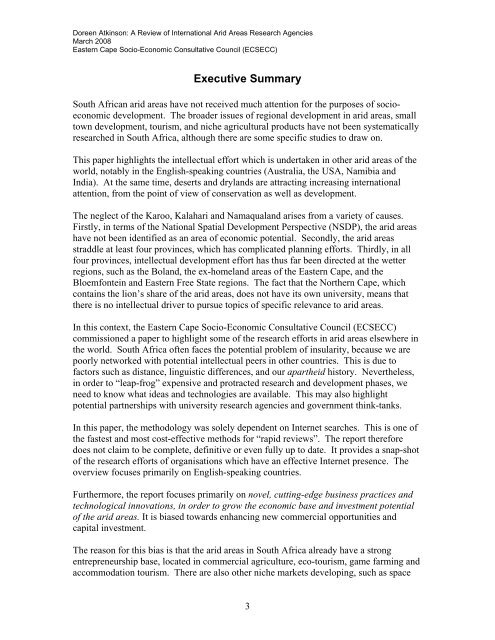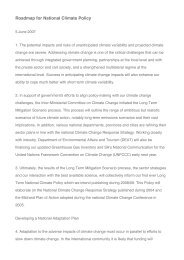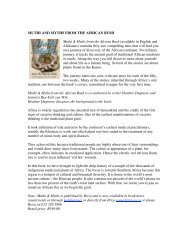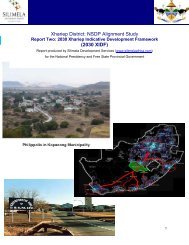report - Arid Areas Programme
report - Arid Areas Programme
report - Arid Areas Programme
You also want an ePaper? Increase the reach of your titles
YUMPU automatically turns print PDFs into web optimized ePapers that Google loves.
Doreen Atkinson: A Review of International <strong>Arid</strong> <strong>Areas</strong> Research Agencies<br />
March 2008<br />
Eastern Cape Socio-Economic Consultative Council (ECSECC)<br />
Executive Summary<br />
South African arid areas have not received much attention for the purposes of socioeconomic<br />
development. The broader issues of regional development in arid areas, small<br />
town development, tourism, and niche agricultural products have not been systematically<br />
researched in South Africa, although there are some specific studies to draw on.<br />
This paper highlights the intellectual effort which is undertaken in other arid areas of the<br />
world, notably in the English-speaking countries (Australia, the USA, Namibia and<br />
India). At the same time, deserts and drylands are attracting increasing international<br />
attention, from the point of view of conservation as well as development.<br />
The neglect of the Karoo, Kalahari and Namaqualand arises from a variety of causes.<br />
Firstly, in terms of the National Spatial Development Perspective (NSDP), the arid areas<br />
have not been identified as an area of economic potential. Secondly, the arid areas<br />
straddle at least four provinces, which has complicated planning efforts. Thirdly, in all<br />
four provinces, intellectual development effort has thus far been directed at the wetter<br />
regions, such as the Boland, the ex-homeland areas of the Eastern Cape, and the<br />
Bloemfontein and Eastern Free State regions. The fact that the Northern Cape, which<br />
contains the lion’s share of the arid areas, does not have its own university, means that<br />
there is no intellectual driver to pursue topics of specific relevance to arid areas.<br />
In this context, the Eastern Cape Socio-Economic Consultative Council (ECSECC)<br />
commissioned a paper to highlight some of the research efforts in arid areas elsewhere in<br />
the world. South Africa often faces the potential problem of insularity, because we are<br />
poorly networked with potential intellectual peers in other countries. This is due to<br />
factors such as distance, linguistic differences, and our apartheid history. Nevertheless,<br />
in order to “leap-frog” expensive and protracted research and development phases, we<br />
need to know what ideas and technologies are available. This may also highlight<br />
potential partnerships with university research agencies and government think-tanks.<br />
In this paper, the methodology was solely dependent on Internet searches. This is one of<br />
the fastest and most cost-effective methods for “rapid reviews”. The <strong>report</strong> therefore<br />
does not claim to be complete, definitive or even fully up to date. It provides a snap-shot<br />
of the research efforts of organisations which have an effective Internet presence. The<br />
overview focuses primarily on English-speaking countries.<br />
Furthermore, the <strong>report</strong> focuses primarily on novel, cutting-edge business practices and<br />
technological innovations, in order to grow the economic base and investment potential<br />
of the arid areas. It is biased towards enhancing new commercial opportunities and<br />
capital investment.<br />
The reason for this bias is that the arid areas in South Africa already have a strong<br />
entrepreneurship base, located in commercial agriculture, eco-tourism, game farming and<br />
accommodation tourism. There are also other niche markets developing, such as space<br />
3






